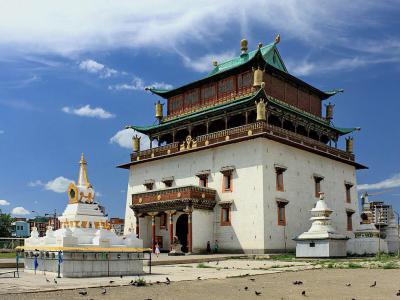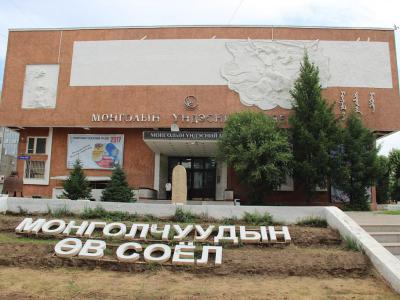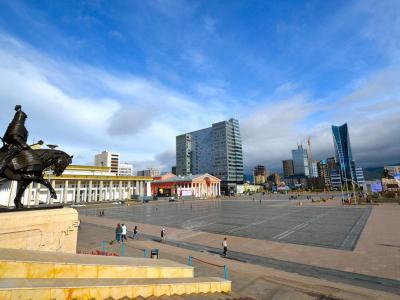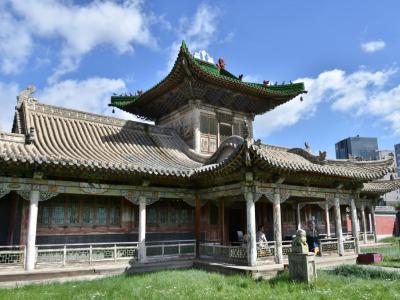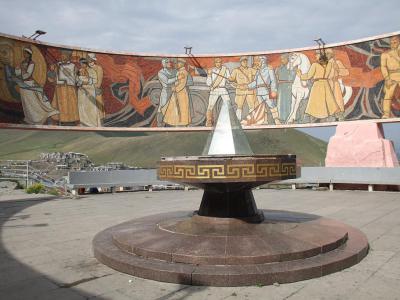Custom Walk in Ulaanbaatar, Mongolia by ub_de6cd created on 2025-03-21
Guide Location: Mongolia » Ulaanbaatar
Guide Type: Custom Walk
# of Sights: 5
Tour Duration: 3 Hour(s)
Travel Distance: 6.7 Km or 4.2 Miles
Share Key: FLHE9
Guide Type: Custom Walk
# of Sights: 5
Tour Duration: 3 Hour(s)
Travel Distance: 6.7 Km or 4.2 Miles
Share Key: FLHE9
How It Works
Please retrieve this walk in the GPSmyCity app. Once done, the app will guide you from one tour stop to the next as if you had a personal tour guide. If you created the walk on this website or come to the page via a link, please follow the instructions below to retrieve the walk in the app.
Retrieve This Walk in App
Step 1. Download the app "GPSmyCity: Walks in 1K+ Cities" on Apple App Store or Google Play Store.
Step 2. In the GPSmyCity app, download(or launch) the guide "Ulaanbaatar Map and Walking Tours".
Step 3. Tap the menu button located at upper right corner of the "Walks" screen and select "Retrieve custom walk". Enter the share key: FLHE9
1) Gandan Monastery (must see)
The Gandantegchinlen Monastery, commonly known as Gandan, is a significant Tibetan Buddhist monastery located in the heart of Ulaanbaatar. Established in 1835 by the Fifth Jebtsundamba, who was Mongolia’s highest reincarnated lama at the time, Gandan translates to "Great Place of Complete Joy." Since the end of communist rule in 1990, the monastery has undergone extensive restoration and revitalization, reestablishing itself as a central hub of Buddhist learning and practice in Mongolia.
The monastery is renowned for its impressive 26.5-meter-high statue of Migjid Janraisig, also known as Avalokitesvara, a bodhisattva embodying compassion. This monumental figure, made from copper sourced from Erdenet and adorned with numerous precious stones, weighs over 20 tons. The statue stands as a symbol of spiritual guidance, representing the path to Truth and enlightenment. The statue's grandeur and the monastery's serene atmosphere make it a focal point of worship and veneration.
The Gandan Monastery complex includes Zanabazar Buddhist University, which serves as a center for advanced studies in Buddhist philosophy, as well as three temples dedicated to the veneration of Avalokiteshvara. It also hosts three colleges focused on Buddhist philosophy, a College of Medicine and Astrology, and two Tantric Colleges. The monastery is a vibrant center of activity, attracting locals from the countryside who visit in traditional costumes to donate, pray, and participate in daily rituals.
Visiting Gandan Monastery offers a peaceful retreat from the bustling city life of Ulaanbaatar. Despite its lack of heating, the monastery remains a tranquil sanctuary year-round. The lively morning services, complete with drumming, chanting, and cymbals, provide a deeply immersive spiritual experience, while the giant Buddha and its surrounding environment create a serene and atmospheric setting. Just a short walk from Sükhbaatar Square, Gandan is a must-visit for anyone seeking to connect with Mongolia’s rich Buddhist heritage and find solace amidst the city’s hustle and bustle.
The monastery is renowned for its impressive 26.5-meter-high statue of Migjid Janraisig, also known as Avalokitesvara, a bodhisattva embodying compassion. This monumental figure, made from copper sourced from Erdenet and adorned with numerous precious stones, weighs over 20 tons. The statue stands as a symbol of spiritual guidance, representing the path to Truth and enlightenment. The statue's grandeur and the monastery's serene atmosphere make it a focal point of worship and veneration.
The Gandan Monastery complex includes Zanabazar Buddhist University, which serves as a center for advanced studies in Buddhist philosophy, as well as three temples dedicated to the veneration of Avalokiteshvara. It also hosts three colleges focused on Buddhist philosophy, a College of Medicine and Astrology, and two Tantric Colleges. The monastery is a vibrant center of activity, attracting locals from the countryside who visit in traditional costumes to donate, pray, and participate in daily rituals.
Visiting Gandan Monastery offers a peaceful retreat from the bustling city life of Ulaanbaatar. Despite its lack of heating, the monastery remains a tranquil sanctuary year-round. The lively morning services, complete with drumming, chanting, and cymbals, provide a deeply immersive spiritual experience, while the giant Buddha and its surrounding environment create a serene and atmospheric setting. Just a short walk from Sükhbaatar Square, Gandan is a must-visit for anyone seeking to connect with Mongolia’s rich Buddhist heritage and find solace amidst the city’s hustle and bustle.
2) National Museum of Mongolia (must see)
The National Museum of Mongolia, previously known as the National Museum of Mongolian History, stands as a vital institution for the preservation and interpretation of Mongolia's cultural and historical heritage. Established through the merger of the historical, archaeological, and ethnographical departments of the State Central Museum and the Museum of the Revolution in 1991, the museum is located in the facility originally built for the Museum of the Revolution, founded in 1971. This transition marked a significant evolution in Mongolia's museological landscape, consolidating various historical artifacts and narratives into a single, comprehensive institution.
The museum's origins trace back to 1924 with the establishment of the Mongolian National Museum, which laid the groundwork for the National Museum of Mongolia. The modern museum now serves as a cultural, scientific, and educational organization responsible for the collection, care, and interpretation of Mongolian artifacts. It holds a vast array of objects that span Mongolia’s rich history, including archaeological finds, ethnographic items, and historical documents.
The National Museum of Mongolia plays a crucial role in safeguarding the nation's cultural heritage. It is recognized as one of Mongolia's leading museums, dedicated to preserving and showcasing the country’s historical and cultural legacy. Visitors to the museum can explore various exhibits that highlight Mongolia’s diverse history, from ancient times through the revolutionary era.
The museum's origins trace back to 1924 with the establishment of the Mongolian National Museum, which laid the groundwork for the National Museum of Mongolia. The modern museum now serves as a cultural, scientific, and educational organization responsible for the collection, care, and interpretation of Mongolian artifacts. It holds a vast array of objects that span Mongolia’s rich history, including archaeological finds, ethnographic items, and historical documents.
The National Museum of Mongolia plays a crucial role in safeguarding the nation's cultural heritage. It is recognized as one of Mongolia's leading museums, dedicated to preserving and showcasing the country’s historical and cultural legacy. Visitors to the museum can explore various exhibits that highlight Mongolia’s diverse history, from ancient times through the revolutionary era.
3) Sükhbaatar Square (must see)
Sükhbaatar Square serves as a central hub of civic and historical significance. Named after Damdin Sükhbaatar, the leader of Mongolia’s 1921 revolution, the square features an impressive statue of him, commemorating his pivotal role in Mongolia’s struggle for independence. The square is strategically located in front of the Saaral Ordon, the official residence of the President of Mongolia.
Dominating the square's northern edge is the Government Palace, an imposing structure built in 1951 that houses the offices of the Mongolian government. Adjacent to it are several key buildings, including the Golomt Bank, the Central Post Office, and the Culture Palace, each contributing to the square’s vibrant atmosphere. Previously, the Sükhbaatar Mausoleum also stood on the square until its removal in 2005.
The square is not only a political and administrative center but also a cultural landmark. In addition to the statue of Sükhbaatar, it is adorned with other notable sculptures, including those of Genghis Khan and his generals, prominently displayed in front of the Government House.
Sükhbaatar Square is a focal point for both locals and visitors, offering a glimpse into Mongolia’s revolutionary past and its present-day significance. It remains a key site for national events and gatherings, reflecting the rich cultural and historical tapestry of Ulaanbaatar.
Dominating the square's northern edge is the Government Palace, an imposing structure built in 1951 that houses the offices of the Mongolian government. Adjacent to it are several key buildings, including the Golomt Bank, the Central Post Office, and the Culture Palace, each contributing to the square’s vibrant atmosphere. Previously, the Sükhbaatar Mausoleum also stood on the square until its removal in 2005.
The square is not only a political and administrative center but also a cultural landmark. In addition to the statue of Sükhbaatar, it is adorned with other notable sculptures, including those of Genghis Khan and his generals, prominently displayed in front of the Government House.
Sükhbaatar Square is a focal point for both locals and visitors, offering a glimpse into Mongolia’s revolutionary past and its present-day significance. It remains a key site for national events and gatherings, reflecting the rich cultural and historical tapestry of Ulaanbaatar.
4) Winter Palace of Bogd Khan (must see)
Considered one of Mongolia’s most important cultural treasures, the Winter Palace of the Bogd Khan was erected from 1893 to 1903 as part of the imperial complex for the eighth Jebtsundamba Khutuktu, who later became the Bogd Khan, the nation’s spiritual head and sovereign during the early 1900s.
What makes the palace especially significant is the extent to which its original contents have been preserved. Today the museum houses more than 8,600 artifacts, including the Bogd Khan’s personal belongings such as his throne, bed, ceremonial robes, gifts from foreign rulers, and even a collection of mounted animals. Equally important are the religious treasures on display, ranging from Buddhist statues and scroll paintings to ritual objects and volumes from the royal library.
Of the four palatial residences once maintained by the Bogd Khan, only the Winter Palace has survived. The site today encompasses the palace itself, several temples, the Gate of Peace and Happiness, and a number of auxiliary buildings, all contributing to an understanding of the scale and diversity of the original complex.
It highlights Mongolia’s architectural traditions, its political and religious history, and the artistic achievements of the era. The grounds include orderly pathways, temples adorned with traditional ornamentation, and courtyards that served both ritual and practical purposes.
What makes the palace especially significant is the extent to which its original contents have been preserved. Today the museum houses more than 8,600 artifacts, including the Bogd Khan’s personal belongings such as his throne, bed, ceremonial robes, gifts from foreign rulers, and even a collection of mounted animals. Equally important are the religious treasures on display, ranging from Buddhist statues and scroll paintings to ritual objects and volumes from the royal library.
Of the four palatial residences once maintained by the Bogd Khan, only the Winter Palace has survived. The site today encompasses the palace itself, several temples, the Gate of Peace and Happiness, and a number of auxiliary buildings, all contributing to an understanding of the scale and diversity of the original complex.
It highlights Mongolia’s architectural traditions, its political and religious history, and the artistic achievements of the era. The grounds include orderly pathways, temples adorned with traditional ornamentation, and courtyards that served both ritual and practical purposes.
5) Zaisan Memorial (must see)
The Zaisan Memorial stands as a poignant tribute to "unknown soldiers and heroes" from various wars, particularly highlighting Soviet contributions. Erected by the Russians, the monument is adorned with vivid socialist realism imagery, including mosaics and reliefs featuring prominent Soviet figures like Stalin and Lenin. The memorial's design reflects the grandiose and ideological art style typical of Soviet commemorative structures.
Perched atop a hill south of the city, the Zaisan Memorial offers stunning panoramic views of Ulaanbaatar and the surrounding landscape, although recent high-rise developments have somewhat diminished the vista. Visitors access the monument via a steep staircase, which adds a sense of pilgrimage to the experience. The climb is rewarded with a striking perspective of the city and its environs.
At the base of the hill lies an imposing tank from the Mongolia People's Tank Brigade, a remnant from WWII. This tank, which saw action against the Nazis, further underscores the memorial's connection to significant historical events and its role in celebrating military valor.
Perched atop a hill south of the city, the Zaisan Memorial offers stunning panoramic views of Ulaanbaatar and the surrounding landscape, although recent high-rise developments have somewhat diminished the vista. Visitors access the monument via a steep staircase, which adds a sense of pilgrimage to the experience. The climb is rewarded with a striking perspective of the city and its environs.
At the base of the hill lies an imposing tank from the Mongolia People's Tank Brigade, a remnant from WWII. This tank, which saw action against the Nazis, further underscores the memorial's connection to significant historical events and its role in celebrating military valor.
